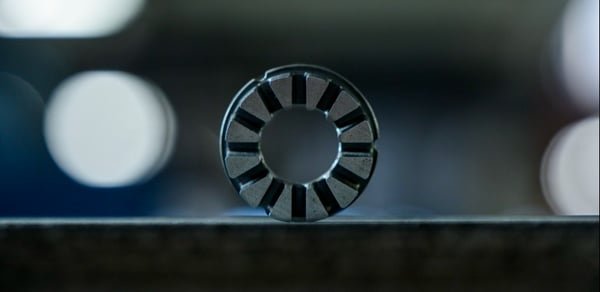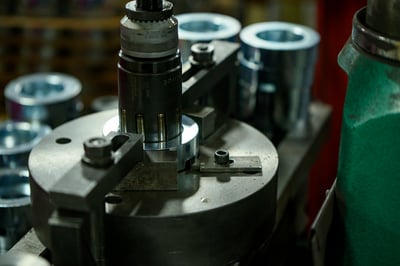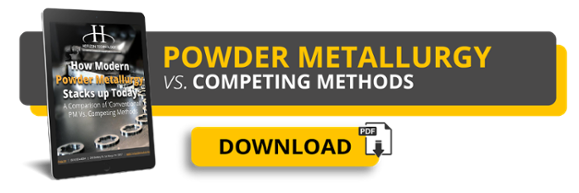All manufacturing processes and technologies have their share of pros and cons. Yet, when it comes to powder metallurgy, few processes have changed for the better in a relatively short period of time.
Today, the advantages of powder metallurgy rival many conventional manufacturing technologies -- even machining -- when it comes to the production of high quantities. There are many angles to look at when comparing powder metallurgy vs. machining -- here are the seven most important:
7 Advantages & Disadvantages of Machining vs. Powder Metal
What are the advantages and disadvantages of CNC machining processes compared to powder metallurgy (PM)? While your project’s specific needs will play some role in that answer, we can still break things down across seven categories. Each will help you better determine which manufacturing process is best for your application:
- Dimensional precision
- Quality
- Design flexibility
- Affordability (tooling and per part)
- Strength
- Speed
- Scrap efficiency
1. Precision
Powder metallurgy creates parts with little -- if any -- error. Your manufacturer has full microstructural control and can customize that microstructure to meet the specific needs of your application. Done correctly, it’s a net-shape part fabrication process that reduces or even eliminates the need for secondary machining. That saves time, energy, and costs throughout the manufacturing stage of product development.
Note that, on a part-to-part basis, PM can not provide the same dimensional precision of modern CNC machining.
Powder metallurgy does offer reliable part-to-part repeatability, which in part explains its popularity for large orders. Powder metallurgy tolerances depend on the material and processing your part requires.
Your small-component manufacturer will have to deal with a bit of distortion inherent to the thermal process every PM part undergoes. Since machining doesn’t involve sintering, it avoids this nagging issue.
 A common axial flux stator made via soft magnetic composite (powder metallurgy), manufactured without machining.
A common axial flux stator made via soft magnetic composite (powder metallurgy), manufactured without machining.
2. Quality
Machining’s quality is dependent on the level of technology you’re using. CNC quality is nearly unmatched; manual machining not so much. If you have access to advanced software and understand CNC machining design guidelines, you can easily match specifications of complex parts.
Not only is the quality of powder metal parts high, you can also take your part’s properties a step further with advanced materials. While most powder metal parts are made from a traditional iron-carbon-copper mix, there’s an abundant array of alternatives available that offer enhanced properties.
Potential additives include:
- Nickel
- Molybdenum
- Chromium (a staple of stainless steels)
- Niobium
- Vanadium
These metals, along with processing steps exclusive to powder metallurgy, can add:
- Corrosion resistance
- Magnetic performance
- Hardness
- Strength (more on this below)
One limitation of the conventional machining process is you can't just throw multiple materials in a blender and get the best properties of both worlds.
Furthermore, machining of hard materials can prove difficult (i.e. stainless steel). What about the machinability of powder metallurgy steel parts, as part of secondary finishing? It's generally a non-issue,. although soft magnetic composites (a material group dedicated to magnetic performance) are usually too brittle to machine.
3. Design Flexibility
Powder metallurgy is an “additive” process, which means that design starts from scratch instead of from a slab of material. With the ability to create from the ground up, you can achieve advanced part designs in an instant. Powder metal gives you the ability to use geometries that would be difficult or wasteful in design for CNC machining.
Even so, there’s a limit to net-shape forming with metal powder. The axial compression delivered by a punch moving into the die means your power metallurgy manufacturer can’t form some features. Either the powder won’t be moved into die, or if it does, release of the part afterward becomes difficult or even impossible. These features include:
- Cross holes (although these can be formed with some newer compaction presses)
- Undercuts
- Threads
- Reverse tapers
However, those features can be added later with machining services.
One of the unique aspects of powder metallurgy is the ability to form helical gears. Most helical gears are in the 20° angle range. PM can mold helical shapes up to 35° -- with zero waste. And, in some of the most advanced powder metallurgy processes, you can even form cross-holes.
 4. Affordability (Tooling & Per Part)
4. Affordability (Tooling & Per Part)
Cost-effectiveness is the predominant reason OEMs request powder metallurgy services. PM wins the cost competition vs. machining thanks to:
- Elimination of process steps
- More efficient material use (more on that below)
- Potential lower energy consumption per component produced vs. starting material, when you factor in material losses due to machining
- Ability to make complex shapes that conserve material
One of the disadvantages of powder metallurgy is that short product runs are a poor fit thanks to per-part costs and tooling costs. For tiny production runs, CNC machining remains a more affordable option. CNC machining requires no tooling costs.
5. Strength
Machining operations can produce parts from materials that take on high tensile forces and impact loads. Today’s machine shops work with some amazingly high-performing materials.
Powder metal parts by nature aren't as strong as machined parts. Why? They have tiny holes, aka porosity.
Keep in mind that powder metal parts can be stronger than you think thanks to advanced sintering technology. Sintering may give your part an acceptable level of strength while allowing you to take advantage of powder metallurgy’s many other advantages over machining.
6. Speed
Powder metal, like cupcakes, is better when the batch is large.
For short-run orders, you may be better off with conventional machining. A machined part only takes a few weeks total. It doesn’t take much effort to put a piece of bar stock in the CNC milling machine and start whittling away.
But once you have a tool in place, that's when powder metallurgy suppliers begin to shine. It’s infinitely better than high-volume-production CNC machining, which requires a lot of:
- Reprogramming
- Retooling
- Labor hours
One of the benefits of prototyping with powder metallurgy over prototype CNC machining is that tooling costs are a one-time investment. If prototype tooling is successful, it carries the added value of being usable throughout final production.
(Related Resource: Prototyping Motor Components With SMC Powder - Benefits vs. CNC Machining Prototype Manufacturers)
7. Scrap Efficiency
Engineers have wondered for years how to best reduce scrap in machining operations.
Powder metallurgy makes far more efficient use of its raw materials -- we’re talking 3% scrap rates. Meanwhile, machining parts can result in 50% material waste. Because the powder metallurgy process is an additive one, your manufacturer only needs as much material as your design requires.
The world now recognizes powder metallurgy as maybe the most sustainable metal manufacturing process, and a model of how to reduce material waste in manufacturing.
While machining scrap can be recycled, these operations still account for significant material costs, much of which is discarded.
The Winner Is … (and More Debate)
There’s no need to start your project with that depressing thought of, “How much material am I paying for that’s going to get thrown away?” Instead, with the right powder metal process, you can dream of the endless design and cost-cutting possibilities you’ve opened up.
The free e-book below reveals more about the pros and cons of powder metallurgy vs.:
- CNC machining
- Stamping
- Casting
- Forging
- MIM -- and more
Don’t miss the chance to discover a cost-cutting or performance-boosting trick you never knew existed!
(This article was originally published in June 2022 and was recently updated)




